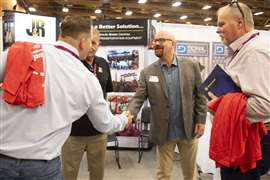The expanding world of telehandlers
18 August 2020
The telehandler market is expanding upwards and downwards, with compact, electric models and heavy duty high risers, among new product initiatives.
Europe is the number one market for telehandlers, with a global share of more than 50%, while the US is number two with around 40%, according to Quentin d’Hérouël, product manager of telescopics at Bobcat.
The European market grew significantly in 2018, says d’Hérouël, to achieve a record of more than 35,000 units sold, and saw steady but slowing growth in 2019. “Growth in Europe has been propelled mainly by France and Germany due to good construction market performance in 2018 as well as agriculture. Rental companies have also renewed their fleets on a massive scale.”
Asia is a fast-growing market but, says d’Hérouël, still doesn’t represent a huge opportunity with less than 1% of the worldwide market. In Asia, India represents more than half of the Asian market. Some manufacturers are putting an effort into converting the Indian market to telehandlers. India traditionally uses pick & carry cranes, which are cheap, easy to fix, but less safe and less productive. Latin America has also seen quite significant growth in 2019, adds d’Hérouël.
According to Josh Taylor, Genie product manager, at Terex AWP, South America seems to be expanding more rapidly than any other area. “The adoption of these types of machines there has been much stronger there than in other developing regions; this is most likely due to the fact that the rental infrastructure there is well developed and palletised freight is very common.”
In the Asia Pacific regions, there are green shoots, adds Taylor, but adoption is slower. “This is most likely because there is still a lot of overlap between telehandlers and small cranes in Asia, so there needs to be a strong argument for convenience and cost advantage for this market to continue to develop.”

Matthew Elvin, CEO at Snorkel, is seeing increasing adoption of telehandlers in Central and Eastern Europe, as well as in Latin America. Elvin adds, “Some of the current trends in telehandlers, include a shift towards more advanced operator controls, with manufacturers introducing more electric over hydraulic controls.
“Contractors are continuing to find more ways to utilise telehandlers on the jobsite, and we are seeing more requests coming from telehandler owners and rental companies for approval of specialised telehandler attachments, designed for certain types of material picking.
“With most telehandlers now fitted with a quick-attach adapter, it has become much easier for telehandler owners to expand the potential uses for this equipment by using a wide range of attachments.”
Power options
“Finally, telehandler OEM’s are continuing to work to maximize the tractive effort from a 74hp engine, to reduce complexity and DEF requirements on small and mid-size telehandlers.”
Snorkel has gone one step further with its lithium-ion battery powered telehandler, the SR626E, unveiled at ConExpo in March this year. It delivers a lifting capacity of 2,600kg, and a maximum lift height of up to 5.79m, while being completely zero emissions. Powered by 80V 300Ah lithium-ion batteries, the SR626E can perform continuously between charges for up to six hours. The on-board charger provides a full charge overnight, while off-board chargers options are available for fast-charging capabilities - up to 2.5 hours for a complete charge.
The SR626E delivers a reduction of up to 60% in operating costs over the diesel equivalent, while also significantly reducing noise. Built to handle rough terrain, the SR626E shares full-time 4-wheel drive and an oscillating axle with its diesel equivalent.
As Elvin, explains, “The move to hybrid and full electric power sources for telehandlers is a little more challenging than for mobile elevating work platforms, as telehandlers generally are used continuously for longer periods of time and drive greater distances which can quickly drain battery power in pick and carry applications.
Another new model in Snorkel’s five-model product line is the SR1065 rough terrain telehandler. It has a lift height of 9.5m, a maximum forward reach of up to 5.4m, and can lift loads up to 6,500kg. Weighing 11,090kg, and powered by a Deutz diesel engine, the heavy-duty SR1065 has full-time four-wheel drive and four-wheel steer, with selectable front, crab and coordinated steering modes.
Product innovations
JLG has also been launching innovative products this year, including in the compact space. All three new telehandlers for the North American market.

Launched at ConExpo, The SkyTrak 3013 ultra-compact telehandler is designed for areas where space is restricted, yet greater lift height and horizontal reach are required. This machine is commonly used in landscape and hardscape applications or for parking garage construction and maintenance. It has a lift height of 13ft and lift capacity of 2,700lbs, and ultra-compact weight of 5,280lbs.
The second new model is the SkyTrak 12054, which is purpose-built for industrial and commercial construction applications. It is the highest capacity telehandler in the SkyTrak family and comes with a single joystick for ease of operation and confident control.
Finally, the JLG 1075 was based on customer requests for a 10,000lb class telehandler with greater lift height and horizontal reach. The model can deliver 6,000 lbs of material to a full eight storey lift height. This can help reduce operating costs and improve jobsite productivity by delaying or eliminating the need for cranes. It has an enviable 60 feet of horizontal reach. As John Boehme, senior product manager, JLG Industries, explains, “The ability to deliver 2,100lbs at 60ft forward means operators can place materials into buildings where the work is being done, reducing material re-handling for improved productivity.”
With its 75ft lift height, the 1075 can deliver materials and equipment well beyond a roof’s edge. So, it can precision place materials on roof tops reducing or eliminating re-handling, explains Boehme. It also has a tight turning radius of just over 13ft, and weight of 43,600lbs, which eliminates the need for special trucks and permits. Products come with SmartLoad, SmartShift and the Sheet Material Handling Attachment.
Boehme says, “Rental company owners and owner/operators are paying more attention to the versatility of each piece of equipment, the productivity gains the telehandler can provide, and the costs after the sale. With the importance of ROI growing, telematics is also on a growth trajectory.”
Expanding on the trends in the North American telehandler market, Boehme adds, “IoT is changing how we develop equipment and how the equipment interacts with each other, operators and technicians. For operators and owners, equipment is becoming more connected and smarter. For rental companies, this connectivity can help improve productivity, maintenance, serviceability, and uptime, helping them to better manage their fleets.”
Latest range
The seven-model range from Skyjack starts at the SJ519TH, which has a 2495kg maximum capacity and a maximum lift height of 5.82m and ends with the ZB2044, which boasts a 9072kg maximum capacity and maximum lift height of 13.67m.

The newest model is the SJ519TH, and it offers a fully opening door operators can use to access the cab with ease and has been nicknamed ‘little big cab’. At its maximum reach of 3.44m, the SJ519 TH can still lift a rated load of 2,000kg. All major service points are easily accessible.
“When we started the design phase for this product, we knew we wanted to maintain similar features with our existing TH series. It is Skyjack’s consistency across products that adds to simplicity of service, and decreased downtime for our customers,” says Malcolm Early, vice president of marketing for Skyjack. Other features include the Smartorque, that provides improved gearing and high efficiency hydraulics, while the Flexcab allows fleet operators to easily convert between open and enclosed cabs with simple hand tools. The Flexdrive allows the operator to reduce drive speed while keeping all function speeds the same.

Caterpillar has been launching products for the North American and global markets. The latest are the Cat TL D Series range, sold predominantly in the Americas. They include the new TL642D, with 2721kg lift capacity and 12m max lifting height.
The Cat TH D Series was also recently launched and is aimed primarily at Africa, Middle East, Europe and some areas of Asia. The TH314D has 3000kg lift capacity and 14m lifting height, while the TH417D has a 4000kg lift capacity and 17m lifting height. The 3.6 engine delivers 74hp - 100hp. The cab is ergonomically designed and comfortable to enhance operators’ productivity. The twin spine chassis and boom design, on the other hand, are sturdy and durable throughout the life of the machine. The engine is side-mounted for class leading ease of serviceability.

Bobcat is launching a new range of 75 HP Stage V compliant telehandlers, aimed primarily at the construction and rental markets. There is a choice of 11 different models, powered by the new Bobcat D34 75 HP Stage V engine, covering maximum lifting capacities between 2.6 and 4.1 tonnes, with lifting heights from 6m to 18m.
There is a new bold styling on the outside of the machine. On the inside, the new D34 Stage V engine allows operation in emission-regulated zones, thanks to the new DPF after-treatment system. The engine does not use Selective Catalytic Reduction (SCR), so there is no need for AdBlue. DPF regeneration is performed automatically, with no impact on. Performance. The engine provides an average 7% lower fuel consumption and offers a 14% higher torque than the previous Stage IV. The new engine hood, with a steeper profile increases visibility and reduces blind spots by 15% on the right hand side of the machines.
These models will be followed by further Stage V models powered by 100 HP and 130 HP versions of the D34 Stage V engine, which are planned to be launched in 2021. These will be a completely new generation of telescopics with a dramatic improvement in user experience.
On the subject of electric versions, d’Hérouël says he is more cautious, “Electrical solutions being used elsewhere are still expensive for the majority of telehandler customers who don’t have a critical need for zero emission solutions, and these customers would definitely refuse to pay this extra cost if these machines do not have sufficient autonomy.”
Industry view

Genie’s latest launch was a refresh of the GTH-844, with a 74hp powertrain, in 2016. Prior to that, the company re-entered the 6,000lb telehandler class with the GTH-636 model in 2014.
The GTH-844 has an 8,000lb capacity, 44ft lift height. The GTH-636 model is a 6,000lb capacity, 36ft lift height telehandler. Both machines feature DEF-free 74hp engines and three-speed powershift transmission, a multifunction joystick, integrated lifting shackle and Genie Lift Connect telematics.
Josh Taylor, Genie product manager, Terex AWP, says, “We pioneered 74hp drivetrains with the GTH-844 and introduced Lift Connect across all of our models last year. Stay tuned; we always work to launch new products.”
On the subject of hybrid and electric development, Josh concurs with previous thoughts. “There is a significant difference in the power density requirement between a telehandler, which can travel long distances at 15mph, and a boom lift, which travels at 3-4 mph for short distances. Additionally, the amount of hydraulic horsepower needed to lift heavy loads for a full shift is a challenge.”
Electric first

Lifting solutions specialists GGR Group has sold the first electric telehandler in the UK to Flannery Plant Hire.The machine will be used as part of works on the new HS2 high speed railway linking up London, the Midlands and the North.
Niall Hester, operations director at Flannery Plant Hire said, “The Electric Telehandler has been very well received on site and has helped set up a concrete compound. The teams were able to get full 10 hour shifts with the machine without needing a re-charge. The machine was then left to charge overnight ready for the next shift. A fast charger was supplied to the customer which would have charged the machine in just under two hours, however it was not needed in the end”.
The new Eco Telehandler is designed and manufactured by Italian company Faresin Industries. It features a lifting capacity of 2.6 tonnes and is powered by a lithium battery.
ConExpo round-up
While ConExpo, back in March this year, may feel like a long time ago, it was the last major exhibition before Covid-19 struck globally and, therefore it is still relevant to revisit these new telehandler products, which were not included in the ConExpo aerial platform round-up in the April-May issue of AI.

Magni Telescopic Handlers debuted the world’s largest rotating telehandler during ConExpo. The RTH 6.51 has a maximum lifting height of 167ft, 4 inches and a maximum forward reach of 113ft, 2 inches. Maximum lifting capacity is 13,200lb. The model includes two attachment modes: strength mode and stability mode.

Manitou debuts at the show included the MTA 12055. The model, is designed and distributed only in North America, and has the largest lifting capacity in the company’s construction telehandler range, offering 12,000lb. It has a lifting height of 55ft 5 in and can carry 5,500lb at full extension and offers a turning radius of 12ft 2 in.

Applied Machinery Sales, Merlo’s US distributor, had the manufacturer’s largest Roto model available to the US market. The R50.35 S-Plus has a 15ft lift, 96ft reach and a maximum capacity of 11,000lb. It offers a 360-degree rotation with a tilt cab and new software.

Dieci had its Pegasus 100.97 on show. The 10000lb, 97,1ft machine has a continuous 360° rotation. It includesa load limiter and outriggers with automatic levelling function. A canBUS control system measures the best working and safety parameters.

Snorkel’s sister company Xtreme Manufacturing used ConExpo to launch a new 17,000lb capacity telehandler. The XR1734-C is the fourth model in the company’s new C-class lineup, which extends the Xtreme’s total product offering to 22 units. The model has a 34ft. maximum lift height, and a mforward reach of 17ft.

Fellow US-based Pettibone introduced the Extendo 1056X to its X-Series line up, providing a 10,000lb capacity machine capable of reaching lift heights of 56ft. It comes standard with a 74hp Cummins Tier 4 Final diesel engine and is the first X-Series model to offer an optional Deutz 74hp Tier 4 engine.



